| |||||
 -
-  - ב"ה - Daily Halachah
- ב"ה - Daily Halachah
Coming Up on Jewish.tv
Laws Relating to the Congregation’s Response to Kaddish, Part 7
By Avraham Meyer Zajac
This webcast begins:
Wednesday, December 13, 2017 at 6am ET
About this series:
Study one halacha or more each day from the Shulchan Aruch (code of Jewish law) authored by the Alter Rebbe, R’ Schneur Zalman of Liadi.
Upcoming Webcasts
By Chaya Sarah Silberberg
By Avraham Meyer Zajac
Aaron L. Raskin
By Avraham Meyer Zajac
By Mendy Gutnick
---
| |||||
 -
-  - ב"ה - Daily Dose
- ב"ה - Daily Dose
By Tzvi Freeman

Chanukah was a victory of few over many. Each Maccabee was a hero, essential to the victory.
One could think that in those days, when the population of the world was so much smaller, a single individual would have more power to change the world. In fact, just the opposite is true. Technology and information have put enormous power in each of our hands.
By Tzvi Freeman
From the wisdom of the Lubavitcher Rebbe, of righteous memory; words and condensation by Rabbi Tzvi Freeman. Subscribe and get your dose daily. Or order Rabbi Freeman’s book, Bringing Heaven Down to Earth, click here.
---Chabad.org Daily DAILY HALACHAH: Shulchan Aruch, Din Aniyas HaKiddush Al Y'dei HaKahal 56:6: Laws Relating to the Congregation’s Response to Kaddish, Part 6"
 -
-  - ב"ה - Daily Halachah
- ב"ה - Daily Halachah
Coming Up on Jewish.tv
Laws Relating to the Congregation’s Response to Kaddish, Part 6
By Avraham Meyer Zajac
This webcast begins:
Tuesday, December 12, 2017 at 6am ET
About this series:
Study one halacha or more each day from the Shulchan Aruch (code of Jewish law) authored by the Alter Rebbe, R’ Schneur Zalman of Liadi.
Upcoming Webcasts
By Avraham Meyer Zajac
By Avraham Meyer Zajac
By Mendy Gutnick
---Chabad.org Daily DAILY DOSE: Staying Above"
 -
-  - ב"ה - Daily Dose
- ב"ה - Daily Dose
By Tzvi Freeman

Never forget that your true place is a place of light. Even when you find yourself in the midst of darkness and sorrow, know that this is not your home.
Where is your home? Where does your true self live?
It lives absorbed within the very origin of light. From there, a glimmer of itself escapes and splashes below.
All it takes is that glimmer to transform the darkness, that it too should shine.
By Tzvi Freeman
From the wisdom of the Lubavitcher Rebbe, of righteous memory; words and condensation by Rabbi Tzvi Freeman. Subscribe and get your dose daily. Or order Rabbi Freeman’s book, Bringing Heaven Down to Earth, click here.
---
| |||||
|
 View Online Version -
View Online Version -  - ב"ה - Happy Chanukah!
- ב"ה - Happy Chanukah!We kindle the first light on the menorah tonight, Dec. 12, 2017
Dear Friend,
Chanukah is coming, and we want to take this opportunity to wish you and yours a very happy and inspiring eight-day Festival of Lights!
We've chosen eight inspiring, informative, and entertaining links to help make your Chanukah special. We hope you enjoy them.
Happy Chanukah!
From your friends at Chabad.org
P.S. Reading and sharing are great, but let’s remember that the most important thing do is to light the menorah. Click here for a full guide with all of the information you need to fulfill this mitzvah.
P.P.S. Be sure to check out our Chanukah event directory. Chances are there is a Chanukah event near you. Click here to search now.
What do you know about Chanukah? Test your knowledge with this 10-question quiz and then share your results with friends.
Get up to speed on the basics of this special holiday in less than five minutes.
What Is Hanukkah?
Info you need about Chanukah
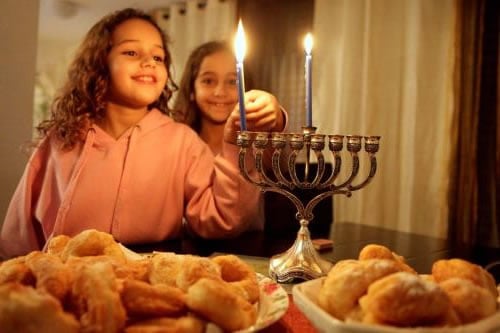
Photo credits: Flash90
Chanukah is the Jewish eight-day, wintertime “festival of lights,” celebrated with a nightly menorah lighting, special prayers and fried foods.
The Hebrew word Chanukah means “dedication,” and is thus named because it celebrates the rededication of the Holy Temple(as you’ll read below). Also spelled Hanukkah (or variations of that spelling), the Hebrew word is actually pronounced with a guttural, “kh” sound, kha-nu-kah, not tcha-new-kah.
What Chanukah Commemorates
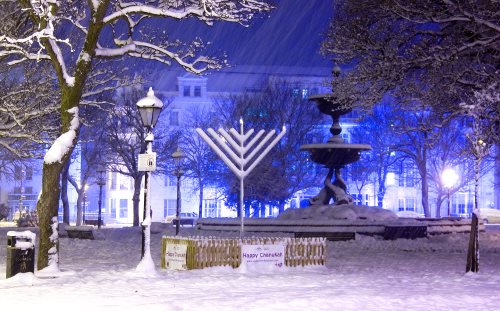
Artist Dominic Alves captured this image of a snowy Chanukah in Brighton, UK.
In the second century BCE, the Holy Land was ruled by the Seleucids (Syrian-Greeks), who tried to force the people of Israel to accept Greek culture and beliefs instead of mitzvah observance and belief in G‑d. Against all odds, a small band of faithful Jews, led by Judah the Maccabee, defeated one of the mightiest armies on earth, drove the Greeks from the land, reclaimed the Holy Temple in Jerusalem and rededicated it to the service of G‑d.
When they sought to light the Temple's Menorah (the seven-branched candelabrum), they found only a single cruse of olive oil that had escaped contamination by the Greeks. Miraculously, they lit the menorah and the one-day supply of oil lasted for eight days, until new oil could be prepared under conditions of ritual purity.
To commemorate and publicize these miracles, the sages instituted the festival of Chanukah.
How Chanukah Is Observed
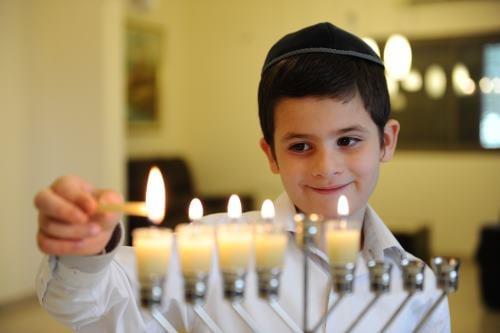
At the heart of the festival is the nightly menorah lighting. The menorah holds nine flames, one of which is the shamash(“attendant”), which is used to kindle the other eight lights. On the first night, we light just one flame. On the second night, an additional flame is lit. By the eighth night of Chanukah, all eight lights are kindled.
Special blessings are recited, often to a traditional melody, before the menorah is lit, and traditional songs are sung afterward.
A menorah is lit in every household (or even by each individual within the household) and placed in a doorway or window. The menorah is also lit in synagogues and other public places. In recent years, thousands of jumbo menorahs have cropped up in front of city halls and legislative buildings, and in malls and parks all over the world.
We recite the special Hallel prayer daily, and add V’Al HaNissim in our daily prayers and in the Grace After Meals, to offer praise and thanksgiving to G‑d for “delivering the strong into the hands of the weak, the many into the hands of the few ... the wicked into the hands of the righteous.”
When Is Chanukah?
Chanukah begins on the eve of Kislev 25 and continues for eight days. On the civil calendar, it generally coincides with the month of December.
Chanukah Foods
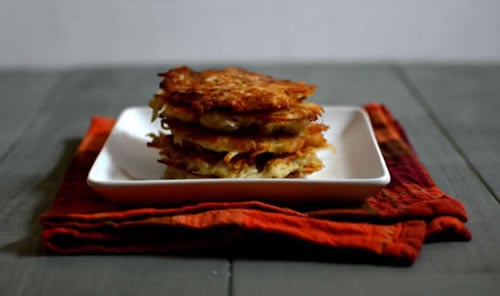
Photo credit: Miriam Szokovski
Since the Chanukah miracle involved oil, it is customary to eat foods fried in oil. The Eastern-European classic is the potato latke(pancake) garnished with applesauce or sour cream, and the reigning Israeli favorite is the jelly-filled sufganya (doughnut).
Dreidel: the Chanukah Game
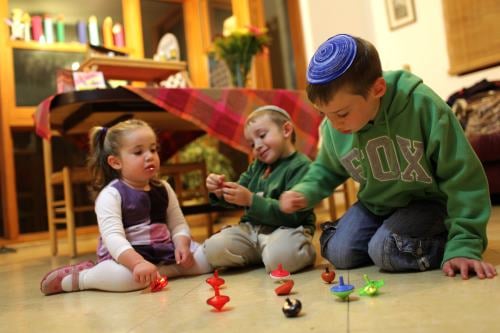
On Chanukah, it is customary to play with a “dreidel” (a four-sided spinning top bearing the Hebrew letters, nun, gimmel, hei and shin, an acronym for nes gadol hayah sham, “a great miracle happened there”). The game is usually played for a pot of coins, nuts, or other stuff, which is won or lost based on which letter the dreidel lands when it is spun.
Chanukah Gelt

In today’s consumer-driven society, people tend to place great importance on giving Chanukah gifts. However, the tradition is actually to give Chanukah gelt, gifts of money, to children. In addition to rewarding positive behavior and devotion to Torah study, the cash gifts give the children the opportunity to give tzedakah (charity). This has also spawned the phenomenon of foil-covered “chocolate gelt.”
Enjoy a Chanukah Lesson From the Rebbe
Play Video
What It Means For You
Noting that one should spend time in close proximity to the Chanukah lights, the Previous Rebbe would say, “We must listen carefully to what the candles are saying.” So what are the flickering flames telling us? Here are some messages:
a. Never be afraid to stand up for what’s right. Judah Maccabee and his band faced daunting odds, but that didn’t stop them. With a prayer on their lips and faith in their heart, they entered the battle of their lives—and won. We can do the same.
b. Always increase in matters of goodness and Torah-observance. Sure, a single flame was good enough for yesterday, but today needs to be even better.
c. A little light goes a long way. The Chanukah candles are lit when dusk is falling. Perched in the doorway, they serve as a beacon for the darkening streets. No matter how dark it is outside, a candle of G‑dly goodness can transform the darkness itself into light.
d. Take it to the streets. Chanukah is unique in that its primary mitzvah is observed in public. It’s not enough to be a Jew at heart, or even at home. Chanukah teaches us to shine outwards into our surroundings with the G‑dly glow of mitzvahs.
e. Don't be ashamed to perform mitzvahs, even if you will feel different. Rather, be like a menorah, proudly proclaiming its radiant uniqueness for all to see.
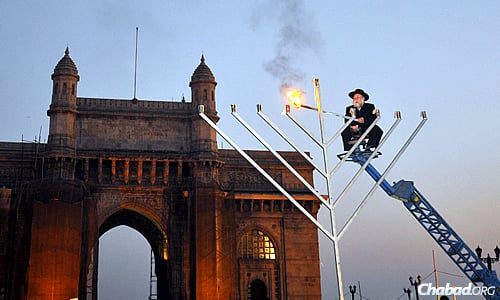
Rabbi Shimon Rosenberg of Afula, Israel, the father of Rivkah Holtzberg, lights a 25-foot steel menorah during Chanukah 2008 in front of the Gateway of India in Mumbai just weeks after his daughter and son-in-law, Rabbi Gavriel Holtzberg, were killed in a terrorist attack. Gavriel Holtzberg would light that menorah each year. (Photo by Serge Attal/Flash90)
They can be found all the way from Times Square to the Red Square. Car-top menorahs tell the world that it's Chanukah time. But where did they come from? Read this article to find out.
Four Decades of Car Menorahs Lighting the Way
With morphing sizes, shapes, materials and vehicles, they’ve become a familiar sight at Chanukah the world over

A menorah is attached to the back of a van in Santa Monica, Calif., circa 1986.
You know them when you see them, and when you see them, you know it’s Chanukah. The car menorah is a uniquely American innovation—a marketing gimmick created by young yeshivah students in the early 1970s as a way to spread awareness and the message of the eight-day Jewish holiday. Today, they can be found across the globe and on all kinds of vehicles. Along with the giant public menorah displays that have become synonymous with Chabad-Lubavitch, these almost accidental inventions have revolutionized the way Jews celebrate Chanukah everywhere.
It was 1973, and the Lubavitcher Rebbe—Rabbi Menachem M. Schneerson, of righteous memory—had just a few years earlier announced his Chanukah-awareness campaign, encouraging his followers and emissaries to reach out to their fellow Jews and give them the opportunity to kindle the Chanukah lights.
Rabbinical students, newlywed couples and veteran rabbis jumped at the chance to disperse throughout their respective communities each year, knocking on doors and standing on sidewalks to distribute holiday fliers and portable menorah kits.
Photo Gallery:
At the time, Shmuel Lipsker was a student at the Central LubavitchYeshiva at Lubavitch World Headquarters, at 770 Eastern Parkway in the Crown Heights neighborhood of Brooklyn, N.Y. As he and his friends prepared to head back to their regular Chanukah spot—the corner of Fifth Avenue and 47th Street in Midtown Manhattan—the boys tried to think of something that might grab the attention of the thousands of New Yorkers who would be rushing by them over the course of the holiday.
“We decided we’d build a large menorah and bring it with us,” recalls Lipsker.
His father, Rabbi Yaakov Lipsker, was a respected Chassid who was also a talented carpenter; in fact, the large and intricately inlaid wooden ark in the main synagogue at 770 is his handiwork. “My father had a lot of building material in the basement,” explains his son, “so there was enough wood for us to play with. We went down there and built a simple wooden menorah out of two-by-fours with a cinder block for a base.”
After roping the cumbersome contraption to the roof of their station wagon, the small group headed off towards the heart of New York City, stopping at a hardware store on the way to pick up flares to light their homemade menorah.
“The whole afternoon we were announcing that we’d be lighting our menorah at 5 p.m.,” continues Rabbi Shmuel Lipsker, today the New York-based administrator of Colel Chabad, a charity founded in 1788 by Rabbi Schneur Zalman of Liadi to support Israel’s needy.
“Now, you have to remember, this was before public menorah-lightings; the concept didn’t exist. It was such a huge attraction. We were giving out menorahs, and more and more people were gathering around us. By the time we lit our menorahs with the flares, we had a huge crowd. It was unbelievable—just a knockout.”

One of the earliest versions of a wooden menorah roped to a car. (Photo: Lubavitch Youth Organization Archives)
The group continued lighting their menorah in Manhattan, and by the next year, a new tool in the fledgling Chanukah campaign was officially born.
But it didn’t come without a few challenges.
Late one night of Chanukah around 1975, the Rebbe was concluding an unscheduled farbrengen (informal gathering) at 770. Outside the synagogue were parked a handful of cars with menorahs attached to their roofs, the vehicles having all just returned from a long evening of distributing small metal menorahs and spreading Chanukah cheer.
As the Rebbe prepared to leave the synagogue to head to his home on nearby President Street, the yeshivah students clambered onto the cars to place flares into the menorahs and light them, hoping the Rebbe would see and be pleased with their work. Seventeen-year-old Bentzion Stock found himself struggling to ignite his last flare as the Rebbe stepped outside.
“One of the flares just wouldn’t light,” recalls Stock, who is now director of Associated Beth Rivka Schools in Brooklyn. “The Rebbe came out and stood there watching me. It was windy; I was getting burnt from the flare, and I was very nervous because I knew the Rebbe was watching. After a few minutes, it still wasn’t lighting, so I climbed down off of the car. Then I see the Rebbe motioning to me that I should get back up.”
Scrambling back on, Stock finally managed to get the stubborn flare to catch fire.
“I looked up,” he says, “and I saw the Rebbe smiling.”

The earliest menorahs were crude, made using two-by-fours with a cinder block for a base. (Photo: Lubavitch Youth Organization Archives)
Innovative Outreach
By the 1980s, many of Chabad’s various innovative outreach methods had already been introduced. Public menorah-lightings were sprouting up around the country, including the National Menorah across from the White House, which was lit by President Jimmy Carter in the midst of the Iranian hostage crisis in 1979. And then there were the RVs—known as Mitzvah Tanks—outfitted with Jewish books, tefillin and Shabbat candles, and driven along the streets of Manhattan, which also helped prompt the appearance of car menorahs.
Contrary to what many believe, the Rebbe did not himself institute the particular outreach methods that his followers developed. “Rather than giving detailed orders, the Rebbe often gave top-line assignments, leaving it to the Chassidim to determine the best strategies and tactics,” writes Rabbi Adin (Even-Israel) Steinsaltz in his recent book My Rebbe. “When the commander says only, ‘You must take that hill,’ the soldiers themselves have to find the way to do so.”
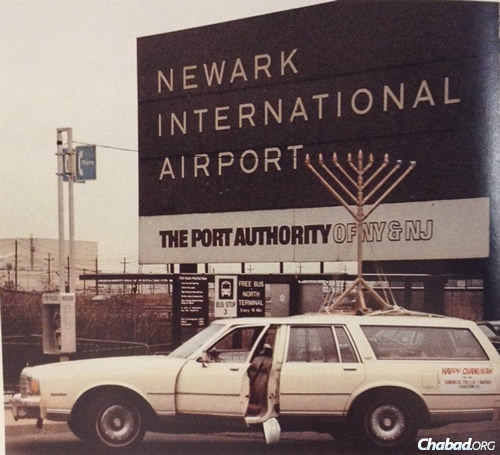
By 1987, as shown in this photo in Newark, N.J., the menorahs had changed a bit.
A case in point was the car menorah.
“Those early car menorahs were crude wooden things,” remembers Rabbi Mendel Feller, who studied in the Oholei Torah Yeshiva in Crown Heights in the mid-1980s. “And we lit the menorah with flares, which looked great but was actually pretty dangerous,” continues Feller who today is rabbi of Upper Midwest Merkos-Lubavitch House in St. Paul, Minn.
Wood was upgraded to plastic PVC pipes until Sholom Ciment, an inquiring 19-year-old classmate of Feller’s at Oholei Torah, saw a yeshivah janitor fixing a broken brass radiator in the winter of 1987. He started asking the man questions, wondering whether he could similarly weld hollow metal tubes in the shape of a menorah, and whether they could run wires through it which they could connect to a car battery via the cigarette lighter.

Truckin' it in Century City, Calif., 1987.
When the janitor affirmed their supposition, the boys got to work creating their light-bulb-topped metal menorahs.
“If I had to guess, I’d say our class made about 40 or 50 of them,” says Ciment, a Boston native who now serves as co-director of Chabad Lubavitch of Greater Boynton Beach in South Florida. “We started working on the menorahs every night—not during study time, of course. All of a sudden, we all became electricians.”
Although the electric lights on the menorahs weren’t suitable for making a Chanukah blessing (the blessing may only be made when kindling an actual flame), the car menorah’s goal was instead Pirsumei Nissa—publicizing the miracle of Chanukah.
“We called various community members in Crown Heights and sold our menorahs at cost to them,” he says. “That year, we made the very first car-menorah parade, which was an incredible sight.”
New Designs, New Thinking

Rabbi M. Hurwitz in Harrisburg, Pa., lighting a menorah on a car roof, 1987.
These days, car-menorah parades can be seen throughout the world. The menorahs themselves show up atop stretch Hummers in Boston; Mini Coopers in Vancouver, British Columbia; Smart Cars in Budapest; and Bentleys in Manchester, England. Car menorahs brighten the dark winter nights as they drive by, reminding pedestrians and drivers alike of the miracle and resilience of the Chanukah story, as well as the power of light.
Development of the car menorah, however, did not end in the 1980s. In the mid-1990s, Nochum Goldschmidt was a yeshivah student studying in Sydney, Australia, when he realized that community members were starting to become more reluctant about placing the still-bulky apparatuses on their vehicles.
“We took a survey in the community, and we got three main complaints: They’re too tall and don’t fit in a garage; they’re too bulky for storage; and they were scratching up people’s cars,” explains Goldschmidt.
So he went back to the drawing board to design a new-and-improved car menorah—one that might satisfy all three issues. He met with success, and shortly thereafter, in 1998, started Carmenorah.com. Sixteen years later, he’s still at it, with thousands and thousands of car menorahs sold. Signs adorning them can be customized for different communities; Goldschmidt has printed Chanukah greetings in German, Spanish, French, Russian and Chinese.

Complete with a light-up sign on a station wagon in Chicago, 1987.
“What’s interesting is that over the years, we’ve begun seeing more and more orders being made from outside the Chabad community,” he notes.
Goldschmidt recently added a sign that simply says “Happy Chanukah,” in addition to the standard “Chabad wishes you a Happy Chanukah.”
“There was a time,” acknowledges Ciment, “when a lot of people weren’t comfortable displaying their Judaism in the public square. Times have changed drastically, and both public menorahs and car menorahs have taken hold in all spectrums of the Jewish community.
“There are literally thousands of public Chanukah displays around the world,” he says, “and that is certainly an innovation of the Rebbe’s.”

A mitzvah tank in Netanya, Israel, 1986.

At an Israeli army base near the Syrian, Jordanian and Lebanese border, circa 1987.
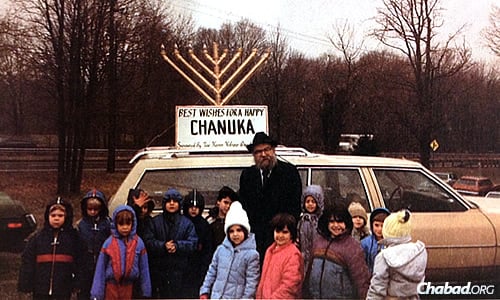
Rabbi Moshe Hecht with students at the New Haven Hebrew Day School in Connecticut, 1987.

Las Vegas awash in even more light from these menorahs.

The Shaloh House Jewish Day School Hummer parade in Boston.
Why we need this holiday now even more than ever.
The Obligation to Illuminate the World
By the Grace of G‑d
On the eve of Chanukah, 5741 [1980]
Brooklyn, NY
To all Participants in the Public
Lighting of the Chanukah Menorah
in the USA
Greeting and Blessing!
Chanukah, the Festival of Lights, recalls the victory—more than 2100 years ago—of a militarily weak but spiritually strong Jewish people over the mighty forces of a ruthless enemy that had overrun the Holy Land and threatened to engulf the land and its people in darkness.
The miraculous victory—culminating with the dedication of the Sanctuary in Jerusalem and the rekindling of the Menorah which had been desecrated and extinguished by the enemy—has been celebrated annually ever since during these eight days of Chanukah, especially by lighting the Chanukah Menorah, also as a symbol and message of the triumph of freedom over oppression, of spirit over matter, of light over darkness.
It is a timely and reassuring message, for the forces of darkness are ever present. Moreover, the danger does not come exclusively from outside; it often lurks close to home, in the form of insidious erosion of time-honored values and principles that are at the foundation of any decent human society. Needless to say, darkness is not chased away by brooms and sticks, but by illumination. Our sages said, “A little light expels a lot of darkness.”
The Chanukah Lights remind us in a most obvious way that illumination begins at home, within oneself and one’s family, by increasing and intensifying the light of Torah and Mitzvos in the everyday experience, even as the Chanukah Lights are kindled in growing numbers from day to day. But though it begins at home, it does not stop there. Such is the nature of light that when one kindles a light for one’s own benefit, it benefits also all who are in the vicinity. Indeed, the Chanukah Lights are expressly meant to illuminate the “outside,” symbolically alluding to the duty to bring light also to those who, for one reason or another, still walk in darkness.
What is true of the individual is true of a nation, especially this great United States, united under G‑d, and generously blessed by G‑d with material as well as spiritual riches. It is surely the duty and privilege of this Nation to promote all the forces of light both at home and abroad, and in a steadily growing measure.
Let us pray that the message of the Chanukah Lights will illuminate the everyday life of everyone personally, and of the society at large, for a brighter life in every respect, both materially and spiritually.
With esteem and blessing in the spirit of Chanukah,
[Signed] M. Schneerson
Letter of the Lubavitcher Rebbe, Rabbi Menachem M. Schneerson, of righteous memory.
© Copyright, all rights reserved. If you enjoyed this article, we encourage you to distribute it further, provided that you comply with Chabad.org's copyright policy.
It's not just about latkes. Try some other traditional and not-so-traditional Chanukah recipes.
Chanukah should not be confined to your home; take it with you wherever you go.
Traveling This Chanukah? 5 Things to Remember!
1. Pack a Menorah

Credit: Judaica of Great Neck
At very least, take with you a box of candles and a simple menorah stand. If you want to go all the way, we recommend those neat, ready-made cups with oil and wicks that you can bring with minimal mess (as well as eight beeswax candles for the shamash). Forgot to pack a menorah? See if you can get tea lights for a perfectly kosher alternative. Line them up in a row and put one candle on top of something small for a shamash. You can light the menorah in your hotel room, just as you would at home.
2. Go Local

Thousands attended the menorah lighting at Brandenburg Gate in Berlin, despite near-freezing temperatures. (Photo: David Osipov)
Locate your closest Chabad-Lubavitch center and make reservations for Chanukah parties, outdoor menorah-lightings and whatever else they may be planning. From Aruba to Alaska, from Madrid to Melbourne, you can count on a public menorah-lighting ceremony and more. Besides giving your Jewish soul some joy, you’ll be experiencing an authentic local tradition.
3. Feed Your Soul

They may not be a mitzvah, but traditional foods have a way of evoking special feelings and memories like nothing else. Even if you won’t be anywhere near a kosher bakery or in the position to fry up some hot potato latkes, you can still savor the oily sweetness of Chanukah with some packaged doughnuts from the kosher supermarket back home. A quick phone call to Franczoz Bakery in Brooklyn, N.Y., tells us that their legendary doughnuts can last at least a week.
Just for fun: Check our mouthwatering collection of Chanukah recipes.
4. Do It Yourself

(Photo: Nati Shohat/Flash90)
It’s at times like this one when Jews sometimes feel lonely isolated in a sea of red, green and gold. Even if you’re on a cruise in middle of the Atlantic Ocean or in one of those rare locations without proximity to a Chabad center, you can send out feelers to fellow travelers. You’ll be delighted to discover members of the tribe with whom to celebrate Chanukah.
5. Go to the Top

Las Vegas awash in even more light from these menorahs.
If you’ll be road-tripping this Chanukah, consider outfitting your car with a menorah that affixes right to the roof (and lights up, to boot). You’ll be spreading the Chanukah message wherever you go, and you’re sure to get lots of waves, smiles, cheers, and, depending where you go, some curious stares.
© Copyright, all rights reserved. If you enjoyed this article, we encourage you to distribute it further, provided that you comply with Chabad.org's copyright policy.
Bet you didn't expect the Kabbalistic masters to have their spin on the dreidel, did you? Well, check this out.
The Kabbalah of the Dreidel
By Yisrael Rice
Do you know the rules of Dreidel? You spin a top with four Hebrew letters on it. A Gimmel wins the whole kitty, a Hei gets you half, Nun gets nothing and for a Shin you must pay in. Aside from the inherent Kabbalistic meaning behind this method, there is the practical Yiddishe origin. Gimmel stands for Gantz, meaning the whole thing. Heiis for Halb, meaning half. Nunstands for Nisht or nothing. And Shin is for Shtell arein or put in.
These are four basic modes of being, depending upon the person, his or her period in life, or the particular day. We all have our Gimmel days. This is when we feel that everything is going great and turning out in a sensational way. (It's been a while, eh?) We have our Hei days, when things are going quite well. The Nun and Shin need no explanation.
 But each of these letters represents only one face of the Dreidel — only a single angle or perspective of the whole. What do the letters spell out? What is the "whole" of the Dreidel? Ness Gadol Hayah Sham, "a great miracle happened there." This refers to the great miracle of Chanukah that occurred in the Holy Land. The situation there seemed dire and beyond hope. They were definitely having a Shin day. The commitment of a few people turned the situation around (like a Dreidel) and brought out the miracle and G‑d's salvation.
But each of these letters represents only one face of the Dreidel — only a single angle or perspective of the whole. What do the letters spell out? What is the "whole" of the Dreidel? Ness Gadol Hayah Sham, "a great miracle happened there." This refers to the great miracle of Chanukah that occurred in the Holy Land. The situation there seemed dire and beyond hope. They were definitely having a Shin day. The commitment of a few people turned the situation around (like a Dreidel) and brought out the miracle and G‑d's salvation.
The Macabees did not dwell on the fact that they were being oppressed and persecuted. They focused on the Gimmel that was on the other side of the Shin. And then they acted to create a vehicle for a Divine miracle.
It is vital to remember that whatever letter we seem to be getting at a particular point in life, it's all part of one Dreidel. And that Dreidel is telling us that miracles happen. We can transform the dark situations of life into the bright light of the Chanukah Menorah. This depends upon our faith in G‑d’s plan, and our commitment to create a vehicle for the miracle.
The Dreidel in the Bible?
Based on this theme we find a phenomenal "coincidence" with these four letters of the Dreidel. The first place where these letters occur as a word in the Torah is in the Parshah (Torah Reading) of Vayigash (Genesis 44-47, always in proximity to Chanukah), where they spell the word Goshnah, meaning "to Goshen."
The Patriarch Jacob was sending his son, Judah, to the Egyptian city of Goshen to set up a house of study, in advance of Jacob's, and his entire family's, relocation to that land. Our patriarch was aware that this was a dreadful descent into exile. But he looked at all of the letters of the Dreidel, and realized that hidden in the exile are the seeds of redemption. Study must continue, especially in exile. As long as we are able to retain the vital Divine information, the exile cannot hold sway over us. And our study and performance become the vehicle for the ultimate redemption.
This is similar to the origin of the Dreidel. According to tradition, during the times of Greek oppression Torah study was forbidden. When the children were studying, they would keep a Dreidel nearby to pull out and play in case they were discovered. (A bit opposite from our Hebrew school experience, perhaps.) At the time, the students may have thought that the game was a distraction from their true purpose in life. But in truth, G‑d conceals His countenance to draw out our commitment and connection to Him. It's all about revealing the Divine in the least likely places. That's what a miracle is.
The Dreidel was the formula to elicit the underlying truth of the Jewish soul.
The Dreidel and Moshiach
And one more idea. If you add up the Gimatria (the Hebrew numerical value) of the letters of the Dreidel, you get 358 (Nun (50) + Gimmel (3) + Hei (5) + Shin (300) = 358). This is the same value as Moshiach (Mem (40) + Shin (300) + Yud (10) + Chet (8) = 358), the Messiah. When the Moshiach comes, he will teach each individual how to see the Divine purpose in every facet of life. Even the time of exile and darkness will be illuminated.
We may have been focusing on one particular letter. Moshiach will teach us to see that all of life is a tapestry of Divine wonder.
Rabbi Yisrael Rice is the Executive Director of Chabad of Marin, Marin County, California and Chairman of the Editorial Board of the Jewish Learning Institute. He is the creator of the "Infinite Within" seminar and author of "The Kabbalah of Now."
Illustration: Mosaic by Chassidic artist Michoel Muchnik.
© Copyright, all rights reserved. If you enjoyed this article, we encourage you to distribute it further, provided that you comply with Chabad.org's copyright policy.
As a single parent, it may be tough to celebrate on their own. Here are few helpful tips from a single mom.
Banishing the Loneliness With Light: Chanukah Tips From a Single Mom

It was the end of a long day of work and childcare. My two kids, ages 4 and 5, were finally asleep, and I had collapsed on the couch to read for a few minutes before tackling the laundry and the dishes.
Shivering, I pulled my sweater more closely around me;It was time to move on, but how? winter had just set in, and the world seemed a dark and dreary place just then.
But duty called. I dragged myself to my feet and headed towards the kitchen, passing my wall calendar on the way to the sink. Was there anything to look forward to over the next few weeks? The fall holidays were over; it was a while till spring. But Chanukah was coming.
Chanukah. I paused. Two years post-divorce, I had passed the initial shock and grief stages of my marriage’s dissolution. But I hadn’t yet found the way to infuse my lonely, meaningless existence with a measure of joie de vivre, or in Hebrew, simchat hachaim. I was raised in a religious family, and I’d learned my whole life the importance of serving G‑d with joy (Ivdu et Hashemb’simchah, as King David says in Psalms 100:2). Right now, though, I wasn’t doing a very good job of it.
I knew it was time to move on, but how?
Maybe I could plan a Chanukah party to banish some of the dreariness I was feeling, I thought suddenly. Nothing big, just my immediate family—my parents, siblings, niece and nephews (who were all quite small at the time). Hosting alone is hard; I’d learned that over the past few years as my repeated attempts to invite company had ended in failure. Even if company came, I ended up feeling like they’d accepted my invitation more out of a sense of pity than out of a real desire to spend time with me and my children. It was easier to just go out for Shabbat and holiday meals than to cook, clean and entertain.
But Chanukah was different. A weekday dinner, which didn’t require the formal holiday meal, could be quite festive. I could pull off theChanukah was different paper goods, program and cooking with just a little help from my younger sisters and my sister-in-law. Yes, I could do this.
I tentatively launched the plan to my children the next day, and they were immediately enthusiastic. A few phone calls later, and we were ready to roll.
When I looked around my full-to-overflowing dining room a few weeks later, my heart was full to overflowing, too. In the window, my Chanukah lights glowed; in my home, a miracle of light shone in my children’s eyes. We, too, could add to the joy of the holiday, even if our family unit was still incomplete. G‑d had shown me the way, and I was so grateful for the gifts of the moment.
Tips on Creating a Chanukah Atmosphere
Buy a menorah (or craft your own) for each member of the family. Even 3-year-olds can light with an adult’s helping hand—and who can resist those brightly colored candles?
Take a few minutes after candle-lighting to enjoy your family. Women, especially, are enjoined to avoid housework or cooking in the first half-hour after the candles are lit (Shulchan Aruch, Orach Chaim 670:1). Sing, play dreidel or read about the Chanukah miracle together. Play Jewish music and invest in a few Chanukah gifts or new toys. It’ll make the lighting time special and create memories for years to come.
Plan your week. Get together with friends or extended family for at least one or two nights of the holiday, and make it fun and exciting by trying delicious dairy recipes (in commemoration of Judith’s defeat of the Greek general), frying latkes or donuts (in commemoration of the miracle of the oil or even just purchasing Chanukah-themed paper goods.
Buy a “Happy Chanukah!” banner or make your own. If you have young children at home, print Chanukah coloring pagesfor them and hang them up on your front door to brighten the atmosphere. One year, we cut dreidels out of colored paper to use as place cards at our party. It’s an activity that even preschoolers can enjoy.
It’s a dark and cold time of year, but don’t let the weather outside pull you down! The Chanukah miracle occurred specifically during the longest nights of the year to teach us that just when things seem the darkest, there’s hope on the horizon.
Avigail Rosenberg is the editor of Healing from the Break: Stories, Inspiration, and Guidance for Anyone Touched by Divorce , and the creator of a divorce resource blog for single parents and others.
Sefira Ross is a freelance designer and illustrator whose original creations grace many Chabad.org pages. Residing in Seattle, Washington, her days are spent between multitasking illustrations and being a mom.
© Copyright, all rights reserved. If you enjoyed this article, we encourage you to distribute it further, provided that you comply with Chabad.org's copyright policy.
We have so many videos, stories, and games to share with you, but we ran out of space. So be sure to visit our Chanukah site. It’s chock full of good things to keep you and your family busy during the holiday.
---Chabad.org Daily "DAILY HALACHAH: Shulchan Aruch, Din Aniyas HaKiddush Al Y'dei HaKahal 56:5: Laws Relating to the Congregation’s Response to Kaddish, Part 5"
 -
-  - ב"ה - Daily Halachah
- ב"ה - Daily Halachah
Coming Up on Jewish.tv
Laws Relating to the Congregation’s Response to Kaddish, Part 5
By Avraham Meyer Zajac
This webcast begins:
Monday, December 11, 2017 at 6am ET
About this series:
Study one halacha or more each day from the Shulchan Aruch (code of Jewish law) authored by the Alter Rebbe, R’ Schneur Zalman of Liadi.
Upcoming Webcasts
By Mendy Gutnick
By Avraham Meyer Zajac
---Chabad.org Daily DAILY DOSE: The Last War"
 -
-  - ב"ה - Daily Dose
- ב"ה - Daily Dose
By Tzvi Freeman

Some people are waiting for a final, apocalyptic war.
But the final war is fought
not on battlefields,
nor at sea,
nor in the skies above.
Neither is it a war between leaders or nations.
The final war is fought in the heart of each human being,
with the armies of his or her deeds in this world.
The final war is the battle of Chanukah
and the miracle of light.
By Tzvi Freeman
From the wisdom of the Lubavitcher Rebbe, of righteous memory; words and condensation by Rabbi Tzvi Freeman. Subscribe and get your dose daily. Or order Rabbi Freeman’s book, Bringing Heaven Down to Earth, click here.
---Chabad.org Daily DAILY HALACHAH: Shulchan Aruch, Din Aniyas HaKiddush Al Y'dei HaKahal 56:4b: Laws Relating to the Congregation’s Response to Kaddish, Part 4"
 -
-  - ב"ה - Daily Halachah
- ב"ה - Daily Halachah
Coming Up on Jewish.tv
Laws Relating to the Congregation’s Response to Kaddish, Part 4
By Avraham Meyer Zajac
This webcast begins:
Sunday, December 10, 2017 at 6am ET
About this series:
Study one halacha or more each day from the Shulchan Aruch (code of Jewish law) authored by the Alter Rebbe, R’ Schneur Zalman of Liadi.
Upcoming Webcasts
By Avraham Meyer Zajac
By Yaakov Brawer
By Avraham Meyer Zajac
By Mendy Gutnick
---Chabad.org Daily "DAILY DOSE: Chanukah Miracles"
 -
-  - ב"ה - Daily Dose
- ב"ה - Daily Dose
By Tzvi Freeman

Without miracles, we might come to believe that the laws of physics define reality. Once we witness the inexplicable, we see that there is a higher reality. And then we look back at physics and say, “This too is a miracle.”
The miracle of a small flask of oil burning for eight days was this sort of miracle.
Then there are those small miracles that occur every day. Those acts of synchronicity we call “coincidence,” because in them G‑d prefers to remain anonymous. But when we open our eyes and hearts, we see there is truly no place void of this wondrous, unlimited G‑d.
These were the sort of miracles the Maccabees saw in their battles against the mighty Greek army.
By Tzvi Freeman
From the wisdom of the Lubavitcher Rebbe, of righteous memory; words and condensation by Rabbi Tzvi Freeman. Subscribe and get your dose daily. Or order Rabbi Freeman’s book, Bringing Heaven Down to Earth, click here.
---Chabad.org Daily "DAILY DOSE: True Lies"
 -
-  - ב"ה - Daily Dose
- ב"ה - Daily Dose
By Tzvi Freeman

In prayer, we are taught, we must stand in perfect stillness, as though overwhelmed and absorbed in the Infinite Light.
But isn’t that a lie? Aren’t we pretending to be something far beyond who we really are?
No—it is the truth. That is the true state of our soul, and the body reflects the soul. Everything that stands between—our minds, our hearts and our egos—all may be oblivious to the state of our souls, but the physical body can still reflect it.
How could that be? How could the physical body reflect that which the mind and heart cannot?
Don’t be so surprised. Very often the most lofty and spiritual can find no other place to be manifest but in the most simple and physical.
By Tzvi Freeman
From the wisdom of the Lubavitcher Rebbe, of righteous memory; words and condensation by Rabbi Tzvi Freeman. Subscribe and get your dose daily. Or order Rabbi Freeman’s book, Bringing Heaven Down to Earth, click here.
---Chabad.org Daily "DAILY HALACHAH: Shulchan Aruch, Din Aniyas HaKiddush Al Y'dei HaKahal 56:3: Laws Relating to the Congregation’s Response to Kaddish, Part 2"
 -
-  - ב"ה - Daily Halachah
- ב"ה - Daily Halachah
Coming Up on Jewish.tv
Laws Relating to the Congregation’s Response to Kaddish, Part 2
By Avraham Meyer Zajac
This webcast begins:
Thursday, December 7, 2017 at 6am ET
About this series:
Study one halacha or more each day from the Shulchan Aruch (code of Jewish law) authored by the Alter Rebbe, R’ Schneur Zalman of Liadi.
Upcoming Webcasts
By Avraham Meyer Zajac
By Avraham Meyer Zajac
By Yaakov Brawer
By Mendy Gutnick
---Chabad.org Daily "DAILY DOSE: Real Idols"
 -
-  - ב"ה - Daily Dose
- ב"ה - Daily Dose
By Tzvi Freeman

Abraham worshipped idols as did his father, Terach. Abraham was an intelligent man, as was Terach. But Abraham came to recognize the falseness of the idols, while Terach stayed behind.
Because Terach never truly believed in the idols and never truly worshipped them. But when Abraham worshipped idols, it was with all his heart, mind and soul, every hour of the day and night. It had to be real.
Everything Abraham did had to be real. And therefore, he found truth.
Siddur Im Dach, Lulav.
By Tzvi Freeman
From the wisdom of the Lubavitcher Rebbe, of righteous memory; words and condensation by Rabbi Tzvi Freeman. Subscribe and get your dose daily. Or order Rabbi Freeman’s book, Bringing Heaven Down to Earth, click here.
---Chabad.org "You are invited to a Farbrengen!"

Farbrengen with the Rebbe: 19 Kislev, 5744
The 19th of Kislev marks the liberation of the Alter Rebbe, founder of Chabad, from czarist prison in 1798. What does the Alter Rebbe’s release from prison have to do with your life today in the 21st century?
This webcast begins:
Wednesday, December 6, 2017 at 8:30pm ET
---
Chabad.org 
Farbrengen with the Rebbe: 19 Kislev, 5744
The 19th of Kislev marks the liberation of the Alter Rebbe, founder of Chabad, from czarist prison in 1798. What does the Alter Rebbe’s release from prison have to do with your life today in the 21st century?
This webcast begins:
Wednesday, December 6, 2017 at 8:30pm ET
---Chabad.org Daily "DAILY HALACHAH: Shulchan Aruch, Din Aniyas HaKiddush Al Y'dei HaKahal 56:1-2: Laws Relating to the Congregation’s Response to Kaddish, Part 1"
 -
-  - ב"ה - Daily Halachah
- ב"ה - Daily Halachah
Coming Up on Jewish.tv
Laws Relating to the Congregation’s Response to Kaddish, Part 1
By Avraham Meyer Zajac
This webcast begins:
Wednesday, December 6, 2017 at 6am ET
About this series:
Study one halacha or more each day from the Shulchan Aruch (code of Jewish law) authored by the Alter Rebbe, R’ Schneur Zalman of Liadi.
Upcoming Webcasts
By Avraham Meyer Zajac
By Avraham Meyer Zajac
By Mendy Gutnick
---
Chabad.org Daily "DAILY DOSE: Unwrapping"
 -
-  - ב"ה - Daily Dose
- ב"ה - Daily Dose
By Tzvi Freeman

We pray and He answers with blessings. But we ask, “If you are already giving us blessings, why in such clumsy packages with so many strings attached?”
And He answers, “If you are giving me your innermost heart in prayer, why in such thick layers of ego? Why with such cold words? Why do you hold back your tears?”
“I’ll make you a deal,” He says. “You bare your souls from their wrappings, and I will bare My blessings of their clouds.”
Maamar Vayigash Elav 5725, 6.
By Tzvi Freeman
From the wisdom of the Lubavitcher Rebbe, of righteous memory; words and condensation by Rabbi Tzvi Freeman. Subscribe and get your dose daily. Or order Rabbi Freeman’s book, Bringing Heaven Down to Earth, click here.
---Chabad.org Daily "DAILY DOSE: Unwrapping"
 -
-  - ב"ה - Daily Dose
- ב"ה - Daily Dose
By Tzvi Freeman

We pray and He answers with blessings. But we ask, “If you are already giving us blessings, why in such clumsy packages with so many strings attached?”
And He answers, “If you are giving me your innermost heart in prayer, why in such thick layers of ego? Why with such cold words? Why do you hold back your tears?”
“I’ll make you a deal,” He says. “You bare your souls from their wrappings, and I will bare My blessings of their clouds.”
Maamar Vayigash Elav 5725, 6.
By Tzvi Freeman
From the wisdom of the Lubavitcher Rebbe, of righteous memory; words and condensation by Rabbi Tzvi Freeman. Subscribe and get your dose daily. Or order Rabbi Freeman’s book, Bringing Heaven Down to Earth, click here.
---


























 Follow us on Twitter
Follow us on Twitter Join us on Facebook
Join us on Facebook
No comments:
Post a Comment